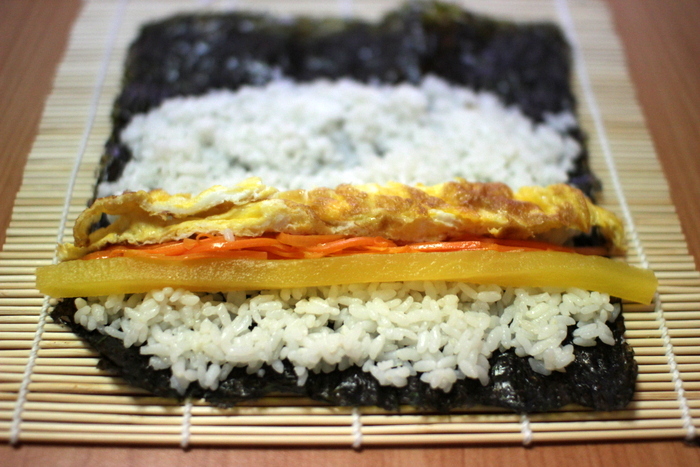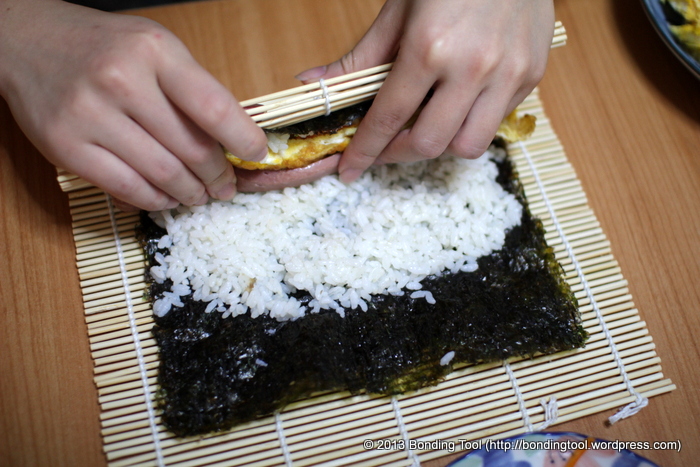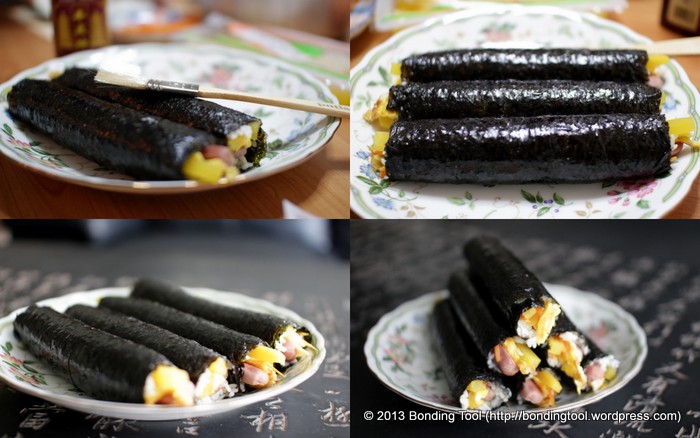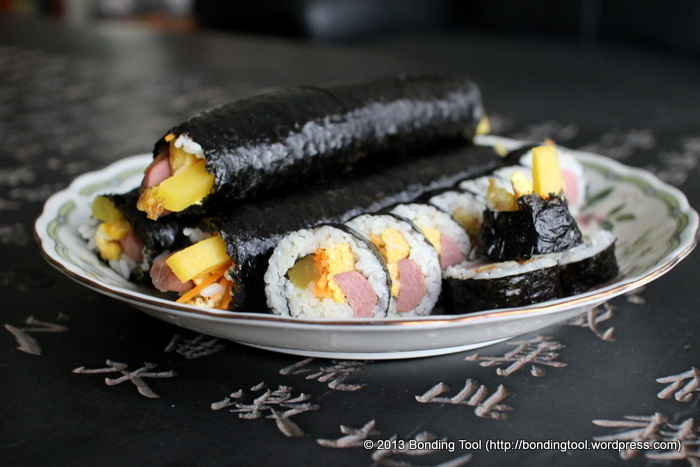Kimbab or Gimbab? In Korean it is 김밥 (kim = seaweed, bab = rice) – written with consonnant “K” and pronounced as “G”. Confusing isn’t it? Many people mistook kimbab for maki at first sight. It is futile to argue the origin of this dish (Japanese or Korean?) so I shall not tread into this argument because some insisted it started in China via some Asian countries, too! As for me, I did not even know kimbab existed until my elder daughter introduced me to it. So you asked again, where does kimbab comes from? Koko Rooloo! That’s the name of the Korean cafe I had my first taste of it. And if you’d asked Seong, he’d probably tell you it originated from his mom’s kitchen :)
Kimbab and Futomaki are seaweed wrapped rice with pickles and other fillings and the similarity stops here. I’m sure you can wiki more information on their differences so I’ll just dive into the making of my first kimbab with Valerie, as my Korean cuisine teacher.
Cook 3 cups of Korean short grain rice in a rice cooker with water level mark 3 (same way as you cook Jasmine rice). Once cooked and whilst hot, sprinkle a pinch of salt and ¼ teaspoon of sesame oil into the rice and fluff to mix well. Set aside.
While rice is steaming in the rice cooker…
Beat eggs and season with a little salt to make omelet. The thickness is up to you. We like our eggs fat and wide.
Saute the carrot julienne strips with a little sesame oil for 3 minutes.
Boil spinach till limp, drain, squeeze away excess water and season with a little salt and sesame oil (we did not get spinach today but they will certainly make the kimbab more colourful and appealing plus you can that extra mineral, iron, in your diet.
Boil canned or frozen sausages in water till cooked. Slice into half lengthwise.
Look at the pictorial steps above and start rolling and squeezing until you get a kimbab log.
Place a piece of kimbab seaweed on the bamboo mat. Put few tablespoons of rice on the seaweed and spread them into a thin layer leaving about an inch of margin for sealing later. Place one dan-mu-ji (Korean pickle), some carrots, one omelet strip (spinach, missing here) and sausage halves.
Roll, press tightly into log shape, release mat, and repeat until the kimbab is formed and sealed.
Once the kimbab is filled and rolled, brush very little sesame oil to moisturise the seaweed. This gives the kimbab extra flavour, shiny good look and also makes slicing easier.
Kimbabs are usually wider and thinner. Using your finger’s width as a guideline, slice the kimbab that thick.
Kimbabs are eaten without any dipping sauce, wasabi or sushi ginger so do season with salt and sesame oil according to your taste before assembling.
Above is the Beef Bulgogi Kimbab, Valerie, made when I was away weeks ago.
Valerie and Seong in traditional Korean costumes.
Kimbab Seaweed
Cook Korean Rice as per normal but with slightly more water, season with a hint salt and sesame oil. Let cool to body temperature.
Meanwhile prepare your “feelings”… What do you feel like having?
Traditional Fillings:
Spinach (pre-boiled and seasoned in sesame, salt and oil).
Carrot (pre-boiled in soy sauce).
Omelet (season with a little salt before frying).
Crab Sticks (surimi).
Dan-mu-ji (Korean Pickles).
Modern Fillings:
(whatever you’ve seen or eaten in a handroll but they have to be cooked not raw in order to qualify as Kimbab). Here are some ideas…
Spam, cut into thick match sticks.
Ham, thick julienne.
Sausages, cut lengthwise (not gourmet sausages).
Beef Bulgogi (chopped).
Cooked Octopus, diced (boil octopus in salted water till tender).
Cheddar Cheese.
Kimchi, press and drain away excess liquid, and chopped.
Smoked Salmon & Cream Cheese.
Tuna, press and drain away excess liquid (chamchi). Tuna and Mayonnaise or Spicy Tuna?
 |
| Kimbab Seaweed. |
 |
| Korean Rice. |
잘 막겼습니다 (I hope you’ll eat well).
Happy experimenting :)










No comments:
Post a Comment